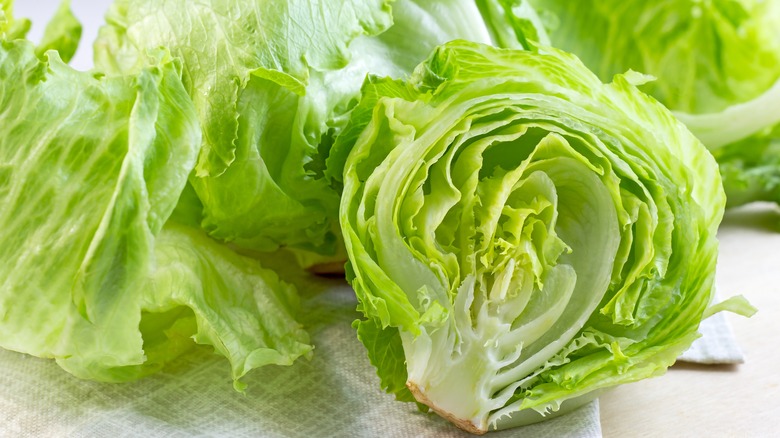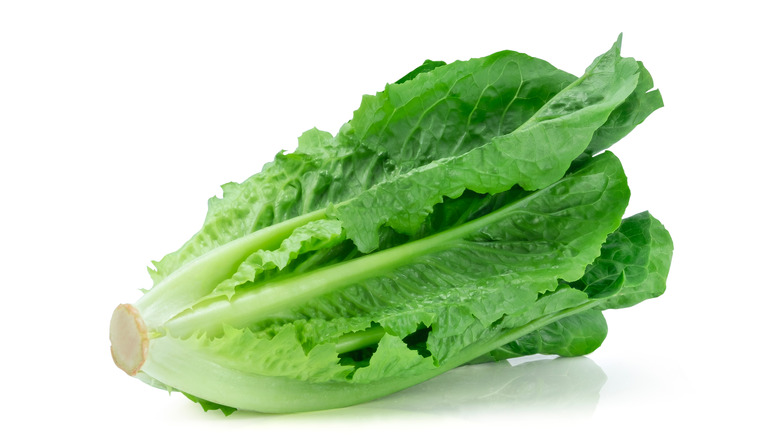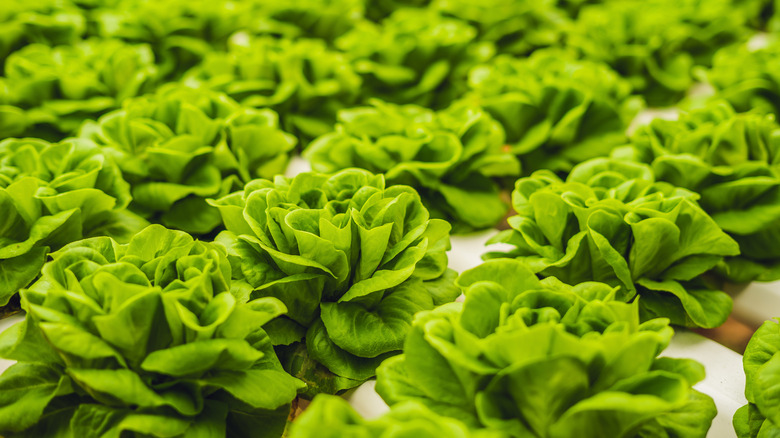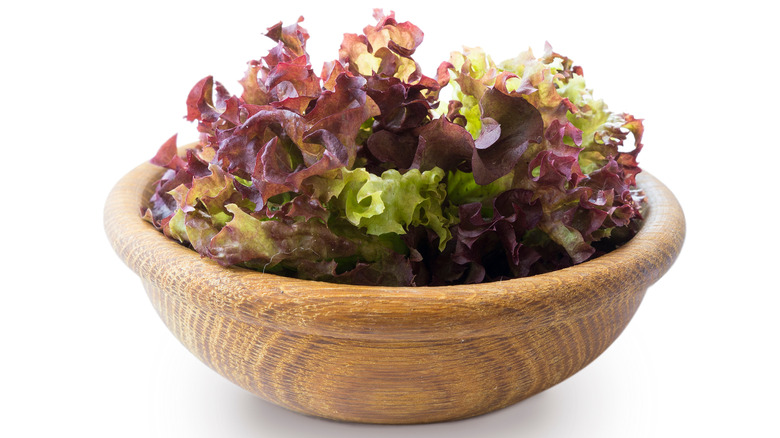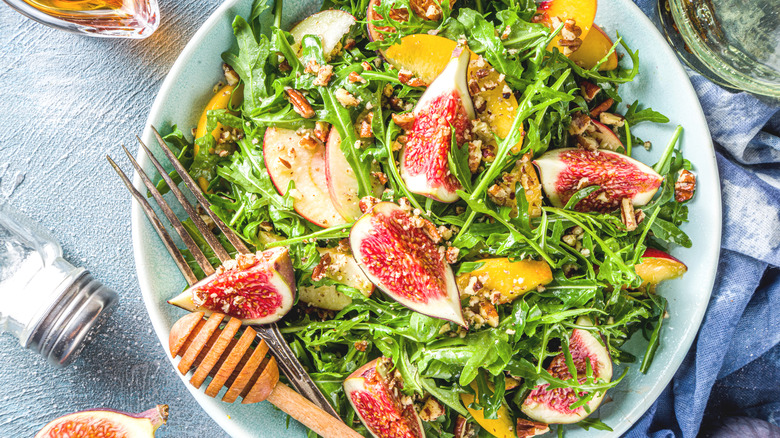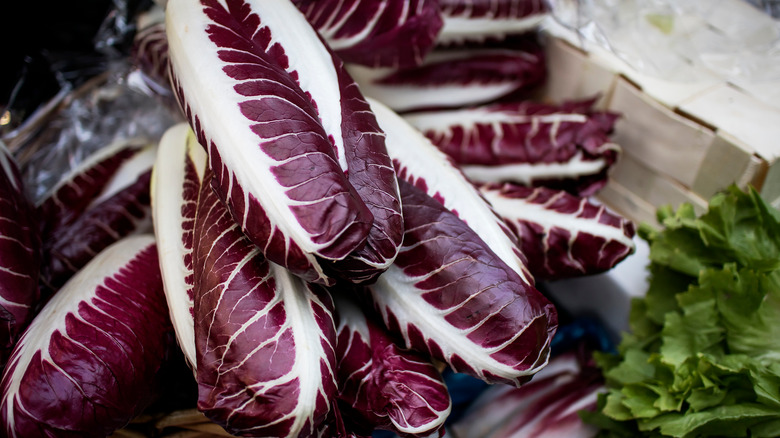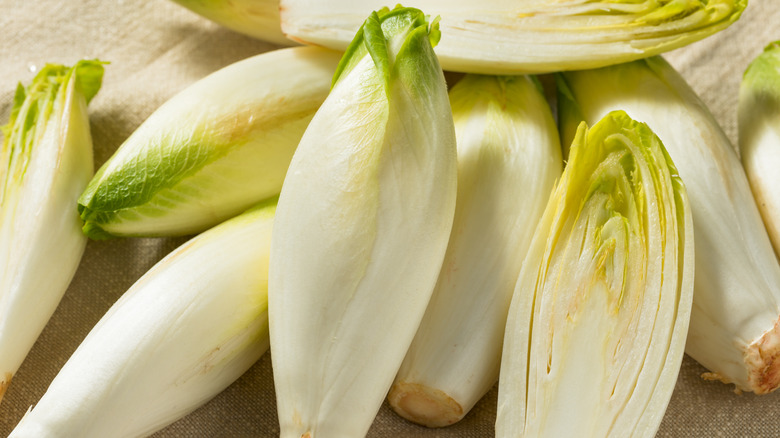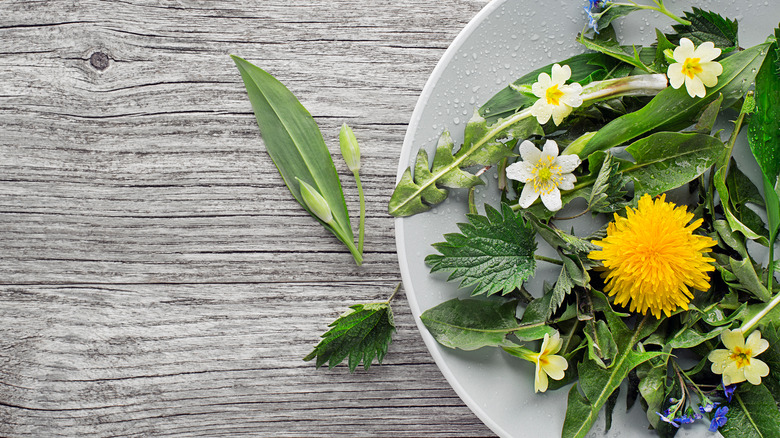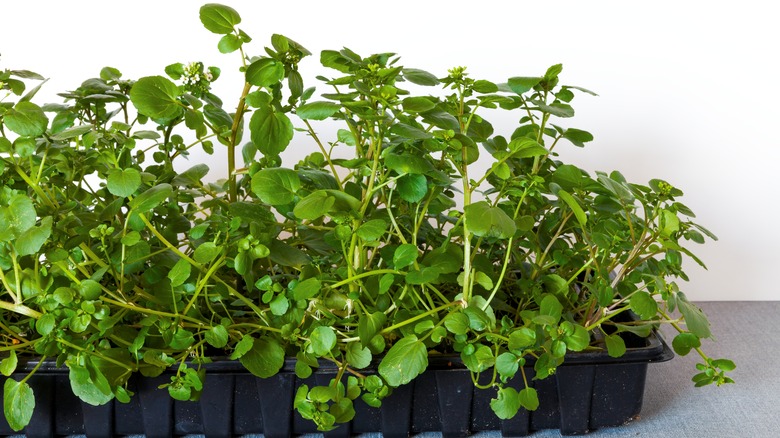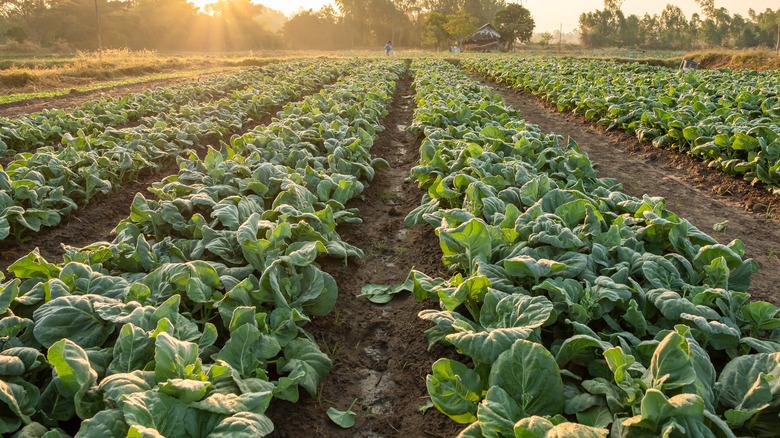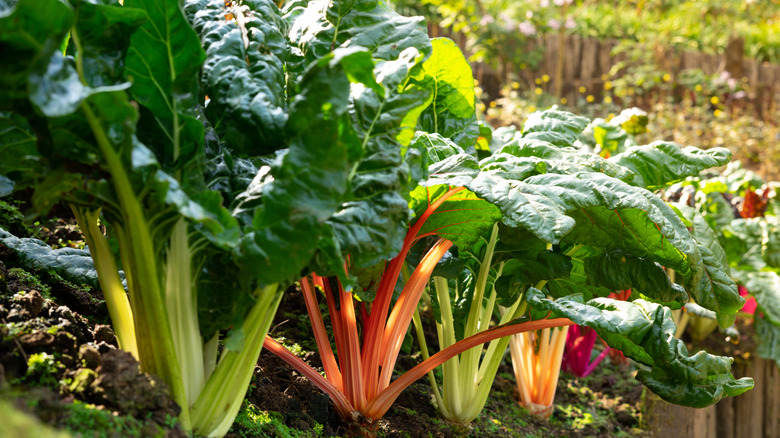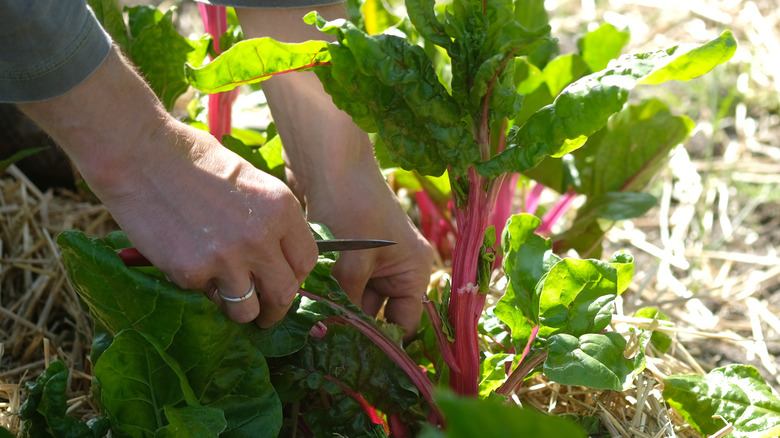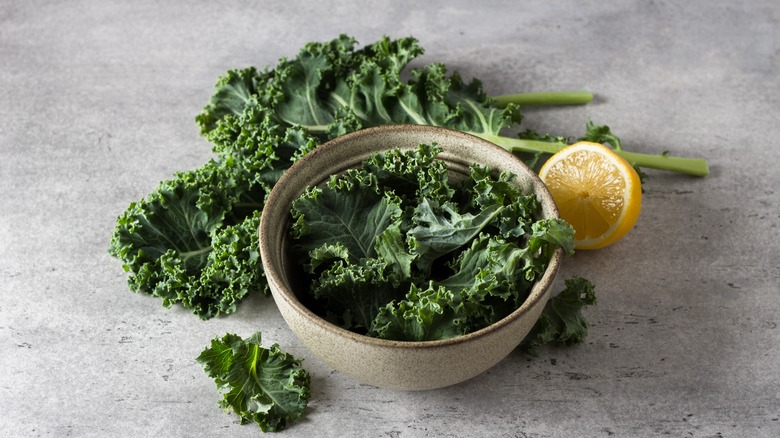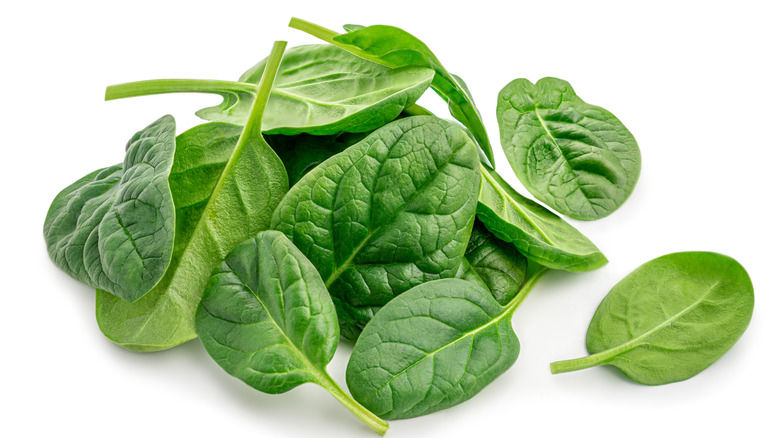Ranking 15 Salad Greens From Worst To Best
We may receive a commission on purchases made from links.
If there's one small habit you should incorporate into your daily diet to help stave off heart disease, promote longevity, lower your risk of getting cancer, prolong your memory, and boost your energy levels, it would simply be to eat more leafy greens (via USDA).
Rich in vitamins, minerals, nutrients, and fiber, leafy greens can be consumed in a variety of ways. To do so, you can use different cooking methods like blending them into a smoothie, cooking them into a side dish, juicing them up with other vegetables and fruits, and adding leafy greens to other dishes like casseroles, pasta, soups, and even baked goods. All told, with a little bit of open-mindedness, you'll find that leafy greens are far more than just a basic salad base.
We think it's safe to say that there's no downside to having a healthy salad at least three to four times per week. Yet not all leafy greens are created equal. We've rounded some of the most popular varieties into a list, ranking them from worst to first, all so you get the best bang for your green buck.
15. Iceberg
As a staple lettuce for wedge salads, cheeseburgers, tacos, and subs, iceberg lettuce is a mild, crisp green that is a must-have for a few classic treats. Yet, taken on its own, iceberg is pretty lackluster. Although there's nothing wrong or detrimental about eating any type of salad green, iceberg lettuce contains a relatively low amount of nutrients, vitamins, fiber, and minerals compared to other greens (via Self). That's partially due to the fact that it contains 96% water, which is more than any of its leafy green counterparts.
Consuming more water by way of iceberg lettuce isn't necessarily a bad thing, but hydration should not be the driving factor for eating leafy greens, making iceberg lettuce the least desirable lettuce option of the bunch. It's also low in calories, with only 14 per 100 grams (via Cooking Light). By comparison, spinach contains 23 calories and kale clocks in at 49 calories per 100 grams. Low-calorie foods might be fine for those who are on a calorie-restricted diet, but that lack of nutritional content doesn't make up for all the other health benefits and nutrients that iceberg lacks, like fiber, calcium, protein, and vitamin C.
14. Romaine
Another crispy, refreshing option in the lettuce aisle is romaine, a preferred leafy greens choice for Caesar salad. It can also be used in place of a burger bun or wrap or as the base in a fancy salad. However, with a high water content similar to iceberg lettuce, there's little room left in the leaves of romaine for vitamins and nutrients, according to Medical News Today. That doesn't mean romaine isn't worth tossing into your next crispy salad, however. Touted as a good source of vitamins A, C, and K, romaine is also abundant in antioxidants, according to EatingWell. These can potentially help boost the body's ability to fight off cancer, Parkinson's disease, Alzheimer's, and other long-term diseases.
Romaine is also rich in potassium and folates, which contribute to the health and wellbeing of the cardiovascular and circulatory systems (via Medical News Today). That said, there are some downsides in opting for romaine, including the potential presence of bacteria and heavy metals that may be absorbed from the soil or from unsafe handling of raw produce, but these harmful effects can be avoided when the lettuce has been washed and stored properly. Try soaking romaine in cold water and a splash of distilled white vinegar to help clean and purify the lettuce before consuming it.
13. Butter leaf
Butter leaf lettuce, also known as Bibb or Boston lettuce, is a tender, buttery lettuce that is mild in flavor (via LettuceInfo.org). It's regarded as an excellent source of vitamins A and K, and is high in other nutrients like folate, calcium and iron, as per Our Everyday Life. Typically grown in the western United States, butter leaf lettuce is also a beneficial source of phytonutrients, which work together with other plant nutrients to help the overall health and wellbeing of your body.
According to Our Everyday Life, butter leaf also contains minerals like copper and iron, which work together to help boost red blood cells in the body and therefore improve the flow of oxygen and reduce blood pressure. Of its many health benefits, it is uniquely advantageous for pregnant women as it contains folates, which prevent birth defects to the brain and spine in a fetus. With large, leafy greens that are easy to peel from the head, butter leaf lettuce is a great option to use as lettuce cup appetizers, or as a replacement for tortillas or sandwich bread.
12. Red leaf
Another lettuce known to be primarily made of water, red leaf lettuce is higher in nutrients and lower in calories than its leafy green counterparts. With 96% water, as per Healthfully, plus a high level of vitamins A and K, red leaf lettuce is considered to be both a hydrating and healthy salad option. According to Healthline, one cup of shredded red leaf lettuce provides 40 micrograms of vitamin K, which contributes 44% of women's daily intake, and 33% of men's.
Red leaf lettuce is also rich in beta-carotene, which plays a vital role in preventing vision loss, promoting healthy skin, and boosting the immune system, according to Healthline. The potassium and magnesium found in red leaf lettuce are known to help improve heart health by lowering blood pressure and preventing cardiovascular disease. Lastly, red leaf lettuce is a low-calorie food that is high in fiber, making it a highly recommended leafy green by doctors prescribing a weight loss diet to patients.
11. Arugula
A member of the mustard greens family, arugula is known as a leafy green to most, but it actually falls under the umbrella of the mustard family, as per Fine Dining Lovers. With a vibrant color and a distinct peppery, robust flavor, arugula is packed with nutrients. Rich in potassium, calcium, antioxidants, and vitamins A, C, and K, this leafy green is also low-calorie, making it pretty attractive from a health standpoint.
Adding arugula to the repertoire of cruciferous vegetables in your diet could lead to potential health benefits like improved vision, weight loss, stronger bones, and may also help lower your risk of cancer. Arugula is native to the Mediterranean, and has been reportedly used as an aphrodisiac but the ancient Romans since the first century (via EcoWatch). Modern research helps back that theory, indicating that dark leafy greens may help block contaminants that may negatively impact sexual desire. Lastly, arugula is a top-notch leafy green option thanks to its versatility in cooking. Try it as a pizza topping, in an omelet, or tossed in alongside some warm or cold pasta.
10. Radicchio
Although not technically green in color, radicchio is a leafy lettuce that belongs to the cabbage family (via Food & Nutrition). Sometimes referred to as red chicory or Italian chicory, radicchio has some impressive health benefits that sets it apart from its leafy green contenders. One major health component specific to the chicory family are its levels of inulin, a non-digestible carbohydrate or type of fiber that helps with digestive health.
According to Verywell Fit, one cup of radicchio provides 112% of the recommended daily values for vitamin K in adult females, and 85% in adult males, making it a uniquely nutritious option. Another health benefit specific to radicchio is its anti-parasitic properties that could help fight off infections caused by parasites such as roundworms (via Healthline). Some may balk at the taste, which can be bitter. However, that may be reduced when radicchio is combined with acidic or sweet ingredients. Try roasting it with balsamic vinegar, adding it to a chopped salad for a burst of bright color, or grilled with olive oil, salt and pepper.
9. Endive
A crunchy, bright, and bitter member of the chicory family, endive is packed with vitamins, nutrients, and minerals. From subtle to bitter, there's a type of endive for everyone including red endive, white endive, and curly endive (also known as frisée). As per Verywell Fit, each variety offers high levels of vitamin K, potassium, folate, and protein, offering distinctive health benefits unique to this variety of chicory. As a low glycemic index food, eating endive may help to reduce spikes in blood sugar, as well as aid in weight loss. Its folate content is also considered crucial for a healthy pregnancy as it reduces the risk of prenatal problems such as premature birth and certain birth defects.
Adding endive to your diet may also improve your night vision, and overall eye health, as it contains beta-carotene and vitamin A, which helps reduce stress caused by light, and in turn sharpens the eye's ability to see in darkness (via Verywell Fit). With its crisp and crunchy texture, endive leaves can be dipped in guacamole or other creamy dips as the perfect substitute for chips or crackers, or served as a stuffed finger-food appetizer. If you can find it and can decide which one of its many varieties works best for you, endive could be well worth the mental effort.
8. Dandelion greens
If you're on a budget, dandelion greens are a great way to incorporate a vitamin and nutrient dense food into your diet without breaking the bank, or adding much to your daily caloric intake, according to SF Gate. Although purchasing dandelion greens at the store may be more convenient, you may also comb through green spaces for them. Dandelions are best picked in spring before the flower has bloomed. Just be aware of the soil in which those dandelions are growing (you may not want to pick them up from ground laced with heavy metals or animal waste, for instance), not to mention any local trespassing laws.
If you can get pass those access hurdles, this leafy green is healthy indeed. With only 25 calories per cup, dandelion greens are rich in vitamins A, C and K, as well as nutrients like lutein, calcium, and zeaxanthin (via Livestrong). If you're unfamiliar with how to eat them, never fear. You can easily add a handful of dandelion greens to raw salad, steam them as a healthy side dish option, cook them in a frying pan with other sautéed vegetables, or blend them in a smoothie. Any of these methods can help you reap the health benefits of this nutrient-dense leafy green.
7. Watercress
According to Healthline, watercress is a spicy, peppery round leafy green that was once considered a weed, but is now recognized by the Centers for Disease Control, which ranks watercress first on a nutrient density score list of powerhouse fruits and vegetables. Watercress is an especially tough competitor when you consider that it's ranked against superfood stalwarts such as spinach and kale. Belonging to the family of cruciferous vegetables, which includes broccoli, cabbage, and cauliflower, watercress has been used in herbal medicine since 500 BCE, when it is said that Hippocrates incorporated watercress into medical remedies (via Watercress Farms Inc).
As per Organic Facts, research indicates that adding watercress to your diet may help fight off cardiovascular disease, strokes, and certain types of cancer, as well as improve bone density, brain health, and immunity health thanks to its vitamins A, B, C, and E, and its mineral content, which includes high levels of iron, magnesium, calcium, and phosphorous. For some diners, watercress may be a bit too strong, but give it a try by using it in salads, as well as chopping it as an herb and adding it to sauces, soups, and sautéed dishes.
6. Collard greens
A staple in the cuisine of the Southern United States, collard greens are a budget-friendly nutrition powerhouse. Ranked as one of the less expensive cruciferous vegetables on the market by the USDA, collard greens are also widely available as a fresh, frozen, or canned leafy green.
According to Prevention, collard greens can help move things along in the digestive system due to its high fiber content, which also helps to protect the stomach from harmful bacteria that may lead to irritable bowel syndrome and other digestive problems. Collard greens are also rich in iron, calcium, magnesium, antioxidants, and vitamins A and K. Health benefits in consuming more collard greens reportedly include a reduced risk of cancer, lower cholesterol levels and blood pressure, improved skin, and boosted brain function.
The sturdy, fibrous leaves of collard greens makes them chewy when consumed raw, but don't let that dissuade you. With a little extra prep and kitchen time, you can enjoy collard greens through popular cooking methods like steaming, braising, and sautéing with spices and herbs. Likewise, though they can be bitter, a few easy fixes can help you make this green more palatable for everyone.
5. Mustard greens
A unique member of the cruciferous vegetable family, mustard greens are one of the few leafy greens that are seasonally available in fall and winter, as per Clean Plates. The bold and peppery flavor of mustard greens mimics that of the mustard condiment, which is made from the seed of the mustard plant. Mustard greens carry a wide variety of nutrients like vitamin C and carotenoids, which help improve eyesight as well as act as an antioxidant with anti-inflammatory properties, as per the journal Molecules.
Another benefit unique to consuming mustard greens is the potential to produce bile acids in the body, which help to lower cholesterol and improve heart health (via Nutrition Research). Unlike the aforementioned collard greens, which are typically too tough and fibrous to use without cooking, the more delicate mustard greens can be enjoyed in a variety of ways. Try them as a raw salad component. If the sometimes pungent taste sounds like a bit much, then know that mustard greens can also be steamed, fried, or added to soups and stews, which can reduce its more intense flavor profile.
4. Swiss chard
Swiss chard and rainbow chard (which come from the same plant but are distinguished by white versus colorful stems) are both low in calories, sodium, and cholesterol, and high in a variety of nutrients like fiber, potassium, and iron (via Healthline). Belonging to the family of plants that also includes beets and spinach, chard has been in use for centuries, primarily in Mediterranean cuisine. With a vitamin E and vitamin A content that is nearly as high as the amount found in spinach, according to SF Gate, chard is clearly a top leafy green contender.
Swiss and rainbow chard can be consumed raw or cooked, with rainbow chard adding a bright pop of color to any salad. Meanwhile, Swiss chard contributes a dark green vibrancy to stir fry dishes, omelets, and as a standalone sautéed side dish. Swiss chard is also known for being a relatively easy and fast growing green that many at-home gardeners incorporate into their repertoires. It also thrives in cooler climates thanks to its sturdy stem and thick leaves, making this a good choice for someone who wants to put in a little time in their garden.
3. Beet greens
Next time you purchase beets to roast, don't just cut off the tops and throw them away. Those dark green and purple leaves are definitely edible, not to mention delicious and extraordinarily nutritious. As per Nutrition and You, beet greens boast many health benefits that extend beyond the more commonly-consumed beetroot, as the greens are known to carry more vitamins, minerals, and fiber. They're also lower in sodium, fat, and calories.
Beet greens also contain high amounts of vitamin C, while a diet high in beet greens is linked to a boosted immune system (via Nutrition and You). According to mindbodygreen, both beet greens and beetroot also contain polyphenols, which are naturally occurring micronutrients full of antioxidants that may help to reduce inflammation. A common method for cooking beet greens is to braise them with lemon and butter. You might also want to try tossing them into the mix along with some roasted beets to reap the most rewards from the entire plant.
2. Kale
Sometimes referred to as the "queen of greens", kale is a clear frontrunner in the produce aisle and has been having a moment in the nutritional mainstream. As a cruciferous veggie, kale is an excellent source of nutrients like fiber, protein, calcium, and vitamin C, among other (via Everyday Health). Its relatively high levels of potassium can also help reduce the risk of stroke and improve heart health.
Like other members of the cruciferous family, kale acts as a natural detoxifier, and consuming more kale may help lower the risk for certain types of cancer, according to Everyday Health. Like with other dark leafy greens, kale can potentially protect your eyesight, support bone health, and lower blood sugar. The only real downside of kale is the prep work involved, which typically includes steps such as soaking, rinsing, trimming, and massaging the leaves to bring out the best flavor and texture.
1. Spinach
In the war of spinach versus kale, spinach takes the cake thanks to its high nutritional content, versatility, and easy preparation. When comparing the nutritional content of spinach with kale, the two are neck in neck in terms of antioxidants and phytonutrients. However, spinach is a clear winner when it comes to iron, magnesium, potassium, zinc, folate, and vitamins A and E. According to Health, the vitamin and mineral content of spinach is shown to help protect your heart, brain, and potentially even your genes.
Additionally, consuming spinach can help with weight loss, given that it's high in fiber, and also triggers metabolic responses that signal a feeling of fullness to the brain. Lastly, while most dark leafy greens are often described as having a bitter taste, spinach is actually on the sweeter side. This makes it an especially versatile green that can be incorporated into just about every meal, from breakfast smoothies to lunchtime sandwiches to a spicy curry at dinner.

